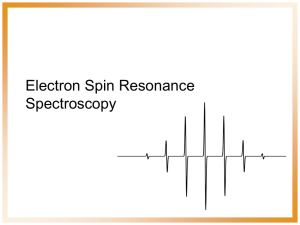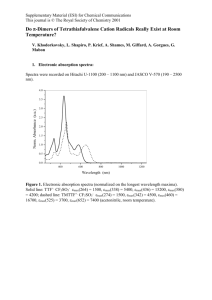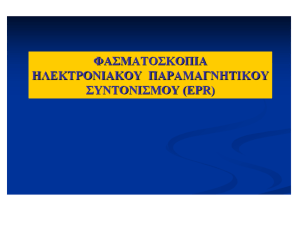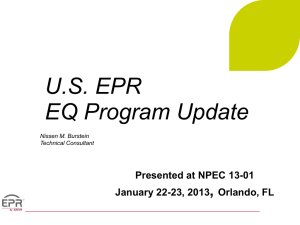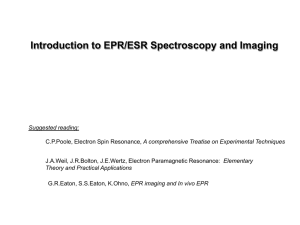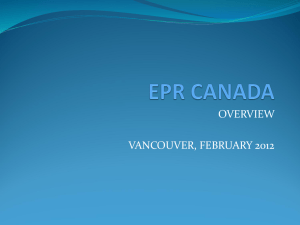EPR Study of Vanadyl Complexes
advertisement
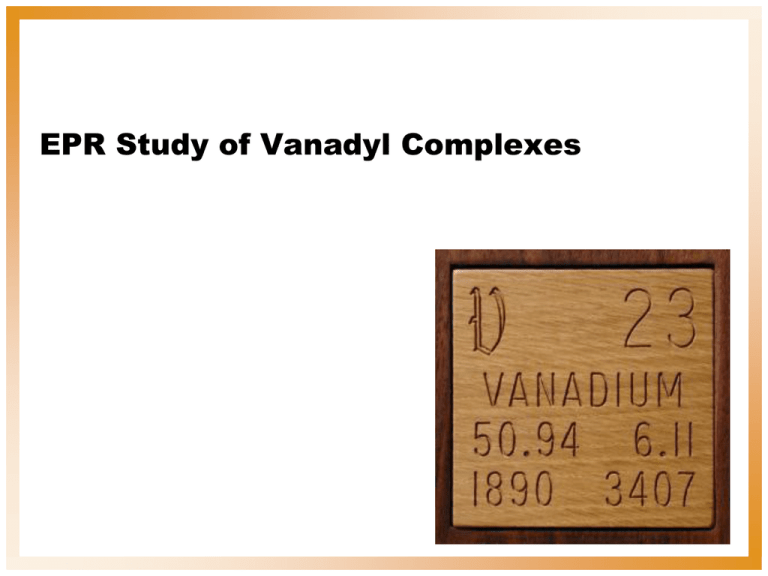
EPR Study of Vanadyl Complexes Experimental Objectives • To synthesize to vanadyl complexes – Vanadyl acetylacetonate – Bis(O,O’-diethyldithiophosphato)oxovanadium (IV) • Compare the EPR spectra of the two complexes • Observe how the variations in the chemical environment affect the spectrum of the same d1 system 2 Chemistry of Vanadium • First discovered by A.M. del Rio (1801) • Rediscovered by N.G. Sefström (1830) • Named for Vanadis • Natural abundance ~0.014% – 19th most abundant element – 5th most abundant transition metal • Primary industrial use is in alloy steels and cast iron VOSO4 – Adds ductility and shock resistance – Iron alloy, ferrovanadium • Formal oxidation states -1 to +5 V Pb5(VO4)3Cl V2O35 Vanadium(IV) • Chemistry is dominated by formation of oxo species – Vanadyl ion, VO2+ • Often a result of hydrolysis of other VIV compounds • Usually blue to green • Form stable complexes with F, Cl, N and O ligands • Frequently 5 coordinate and square pyrimidal • Many compounds containing the vanadyl unit have two characteristic features: VOSO4 – EPR spectrum • Characteristic g values • 51V hyperfine coupling VO(acac)2 – Strong V=O stretching band A brief review of EPR spectroscopy… Acta Crystallogr., Sect. C: Cryst. Struct. Commun. 1995, C51, 12-14 4 ESR Spectroscopy • Electron Spin Resonance Spectroscopy • Also called EPR Spectroscopy – Electron Paramagnetic Resonance Spectroscopy • Applicable for species with one or more unpaired electrons • ESR measures the transition between the electron spin energy levels in a magnetic field – Transition induced by the appropriate frequency radiation • Required frequency of radiation dependent upon strength of magnetic field – Common field strengths 9.5 and 35 GHz (microwave region) • Important features of the spectrum – Proportionality factor, g – Hyperfine interactions 5 How does the spectrometer work? 6 Proportionality Factor • Measured from the center of the signal hν 714.48 ν (GHz) • g= • For a free electron – 2.00232 For organic radicals – Typically close to freeelectron value – 1.99-2.01 For transition metal compounds – Large variations due to spin-orbit coupling and zero-field splitting – 1.4-3.0 • • μ B Bo B (G) 7 Proportionality Factor MoO(SCN)52- 1.935 VO(acac)2 1.968 e- 2.0023 CH3 2.0026 C14H10 (anthracene) cation 2.0028 C14H10 (anthracene) anion 2.0029 Cu(acac)2 2.13 8 Hyperfine Interactions • • • • • • • EPR signal is ‘split’ by neighboring nuclei – Called hyperfine interactions Provides information about number and identity of nuclei and their distance from unpaired electron Selection rules same as for NMR Every isotope of every element has a ground state nuclear spin quantum number, I – has value of n/2, n is an integer Isotopes with even atomic number and even mass number have I = 0, and have no EPR spectra – 12C, 28Si, 56Fe, … Isotopes with odd atomic number and even mass number have n even – 2H, 10B, 14N, … Isotopes with odd mass number have n odd – 1H, 13C, 19F, 55Mn, … 9 Hyperfine Interactions • Coupling patterns (or splitting) same as in NMR • More common to see coupling to nuclei with I > ½ • The number of lines = 2NI + 1 • • Only determines the number of lines--not the intensities Relative intensities determined by the number of interacting nuclei If only one nucleus interacting – All lines have equal intensity If multiple nuclei interacting – Distributions derived based upon spin – For spin ½ (most common), intensities follow binomial distribution • • Relative Intensities for I = ½ N Relative Intensities 0 1 1 1:1 2 1:2:1 3 1:3:3:1 4 1:4:6:4:1 5 1 : 5 : 10 : 10 : 5 : 1 6 1 : 6 : 15 : 20 : 15 : 6 : 1 11 Relative Intensities for I = ½ 12 Relative Intensities for I = 1 N Relative Intensities 0 1 1 1:1:1 2 1:2:3:2:1 3 1:3:6:7:6:3:1 4 1 : 4 : 10 : 16 : 19 : 16 : 10 : 4 : 1 5 1 : 5 : 15 : 20 : 45 : 51 : 45 : 20 : 15 : 5 : 1 6 1 : 6 : 21 : 40 : 80 : 116 : 141 : 116 : 80 : 40 : 21 : 6 : 1 13 Relative Intensities for I = 1 14 Hyperfine Interactions • Coupling to several sets of nuclei – First couple to the nearest set of nuclei • Largest a value – Split each of those lines by the coupling to the next closest nuclei • Next largest a value – Continue 2-3 bonds away from location of unpaired electron 15 Hyperfine Interactions • Example: – Pyrazine anion – Electron delocalized over ring • Exhibits coupling to two equivalent N (I = 1) 2NI + 1 = 2(2)(1) + 1 = 5 • Then couples to four equivalent H (I = ½) 2NI + 1 = 2(4)(1/2) + 1 = 5 – So spectrum should be a quintet with intensities 1:2:3:2:1 and each of those lines should be split into quintets with intensities 1:4:6:4:1 16 Hyperfine Interactions EPR spectrum of pyrazine radical anion 17 Experiment Overview • Begin synthesis of VO(dtp)2 • While cooling, synthesize VO(acac)2 • Collect both complexes • Determine – IR spectra – EPR spectra 18 Safety/Tips • Dispose of all waste in the appropriately labeled waste containers – do not throw solutions down the drain • Wear your safety glasses at all times • If you should get any reagents on your skin, rinse with plenty of water and tell your TA • Be sure VOSO4 is completely dissolved before adding ligand • VO(acac)2 – add NaHCO3 slowly with vigorous stirring 19

